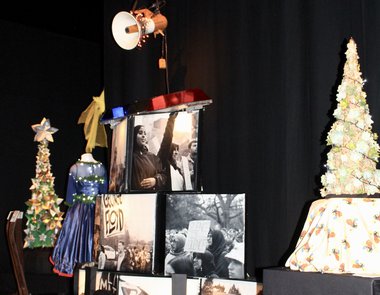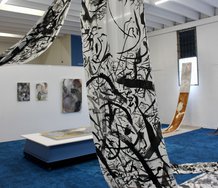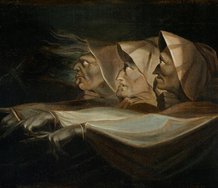Norman Franke – 22 December, 2020
As at previous exhibitions, the categories of this year's show are connected to current, socially relevant issues. There are seven categories under which the installations could be entered: Quarantrees; Gadget Trees; Kiwiana Trees; Black Lives Matter trees; Avantgarde trees; Recycled trees; and Mini trees.
Hamilton
Community project
Trees at the Meteor
13 December - 18 December, 2020
For many of those who, like me, grew up in the Northern Hemisphere, New Zealand Christmas rituals always hold a special fascination. As a child, I would never have imagined having a barbecue with whānau outside on the terrace at Christmas time or taking long walks on the beach by the summer sea. Conversely, it was only in Aotearoa that I became fully aware of how closely the Christmas rituals in Europe are related to the climatic conditions in the Northern Hemisphere.
Take the symbolism of light:—candles on an Advent wreath, the chain of lights on a Christmas tree, Christmas market illuminations —their effect on the mind, their cosiness or stunningness, only fully unfolds against the grey clouds and early sunsets of Northern European winter skies. Similarly, a lot of Christmas carols refer to darkness and snowy nights, as some of the old pagan mid-winter customs were fused with the narrative of Christ’s birth in the vicinity of the winter solstice. In the Bleak Midwinter is arguably more catchy in a cathedral in Northern England than in New Zealand’s sun-drenched churches; and Good King Wenceslas’s page, who wades confused through the deep snow, appears as both a historical and geographical anachronism in an Aotearoan context. Many New Zealand tamariki get to know snow first from afar, with a view of the snow-capped peaks of Mount Ruapehu, and then perhaps later on the volcano’s ski fields.
For many years, Trees at the Meteor has been an integral part of the Hamilton cultural calendar in the run-up to Christmas and a fixture of the festive season in the Waikato (1). Simply put, it is an exhibition of self-made, often artistically designed and mostly sustainable Christmas trees, which are exhibited in the Community Centre of Hamilton’s Meteor Theatre (2) immediately before Christmas. But Trees at the Meteor is much more than that.
If elsewhere (especially in Auckland) there is the ingrained prejudice about Hamilton as a series of swanky suburbs in which the aspiring petty bourgeoisie lives in oversized houses with fake 4-wheel drives but no clue about culture, then a visit to Trees at the Meteor may be an antidote to the old stereotype. The exhibition showcases the best of the Waikato region and ‘Middle New Zealand’: cheerful creativity and a sense of community. Often, the trees or tree-like installations have a meditative, socially aware and ‘interactive’ Christmas dimension.
As at previous exhibitions, the categories of this year’s show are connected to current, socially relevant issues. There are seven categories under which the installations could be entered: Quarantrees (‘our own little treedom freedom to share our own panacea on the pandemic’); Gadget Trees (‘these trees have gizmos and gadgets aplenty!’); Kiwiana Trees (‘these trees are a celebration of what makes Aotearoa unique’); Black Lives Matter trees (‘the Black Lives Matter movement won’t let the world forget we all have work to do as a planet’); Avantgarde trees (‘a tree that grows in the left field—exhibiting innovation, novelty and originality’); Recycled trees (‘transforming waste into something aesthetic’); and Mini trees (‘Haere mai bonsai! Less is more! A smorgasbord of tiny teeny incy wincy waif like little beauties!’) (3).
Even setting up the trees is a communal activity and a shared pleasure. You may see young and old, representatives of various religious, ideological and ethnic groups, single fathers with teenagers, an artist collective from Wintec, a kindergarten delegation, two neighbours in overalls and with welding torches, dragging their trees. Each tree is given the most congenial place possible and a safety check. And finally they all stand together in the halls of the Meteor Theatre, a former lemonade factory, which, by the way, was built by one of the great architects of modernism, Henry Kulka (4). Some of the artwork is huge, some small; you find a 4m tall Pōhutukawa blossom next to tiny dollhouse trees. Some of the tree installations are interactive, for example the ‘Christmas PoeTree’ which invites you to write your own Christmas poems and hang them as leaves on the barren branches. Some trees such as a white cone made by a group of Waikato Hospital nurses of prothetic moulds reconnect the visitors with (broken) dreams and hope of survival during the ‘annus horribilis’ that has been.
Coming back to some childhood memories of a Northern Hemisphere Christmas. For many, the time elicits ‘Proustian memories,’ such as the festively decorated and illuminated shop windows, the glitter of tree decorations and lights, the smell of real beeswax candles and the roast in the oven. Even the most common living rooms briefly turn into enchanted spaces; during the Christmas holidays, calendar constraints and the treadmill of work are suspended for a while at the end of the year. You can sense the spreading of a fine anarchic vibe: friends and family sleep in, taste exquisite things, watch their old favourite films again or read new books.
I am deliberately romanticising a little here; but the romanticising and re-enchanting of the world may precisely be one of the points of the Christmas season and some of its traditional rituals, too. There is a hint of magic, of a comprehensive sense of community and artistic living that involves all the senses, and that relates to childhood with its sense of wonderment, the time when everyone is still an artist. As a saying attributed to Picasso says: ‘All children are born artists, the problem is to remain an artist as we grow up.’ (5) For many, however, it is only during the Christmas season that Western bourgeois ‘normalcy,’ with its incessant rat-race and consumerism, gets suspended or questioned and makes way for that intense soulfulness of shared songs, meals and gifts. There are some contemporary artists who—in the romantic tradition—try to overcome the banalisation of modern everyday life through creativity and smuggling in some of the Christmas magic. One of them is the Austrian-born architect and painter Friedensreich Hundertwasser, who for a long time lived in Northland near Kawakawa and whose last posthumous building is currently under construction in Whangarei (6). Commenting on the banality of modern urban planning, modern entertainment and everyday life—their ‘straight lines,’ their boring and uninspired plots and facades—Hundertwasser submitted: ‘Visual pollution is more poisonous than any other pollution because it kills the soul.’ (7)
In a modern age that has become monotonous, functional and profane in the extreme, Hundertwasser pleads for spaces and communities based on spontaneity, inventiveness and the joy of communal co-creation. In his imaginative ecological buildings, such as the Hundertwasser House in Vienna, you can find roof gardens for summer picnics and mulled wine in winter, gilded domes glittering in the moonlight (much cheaper than one might think) and green balconies for fruit trees that provide spaces for colourful avian neighbours. His architecture and projects rely on the cooperation of residents and communities: ‘Paradises can only be made with our own hands, with our own creativity in harmony with the free creativity of nature.’ (8) Hundertwasser deplored the systematic driving out of most people’s creativity after they have left school (‘Our real illiteracy is our inability to create’) (9). At many schools, you can often still do a little tinkering and painting or poetry; for the vast majority of adults, however, their own creativity is as remote as the MACS0647-JD galaxy. Hundertwasser created places of everyday beauty, wonder and creative collaboration together with people from wide range of social backgrounds.
Trees at the Meteor also displays this sense of communal magic that lets visitors immerse themselves in a world of wonder: after the exhibition, many visitors step into the summer night with new sensory impressions, ideas and the desire to finally be creative again themselves. The joint creativity of Trees at the Meteor is akin to Hundertwasser’s observation: ‘If one person dreams alone … It is only a dream. When many people dream together … It is the beginning of a new reality.’ (10)
Where does the custom of putting up trees for Christmas come from? There are different theories (11). Presumably, evergreen plants as signs of hope for spring and rebirth were already set up by the ancient Celts and Germans. In this respect, the mistletoe is a symbolic cousin of the evergreen spruce and fir trees that are traditionally used as Christmas trees in Europe. Christmas trees, perhaps reminiscent of old pagan (world ash Yggdrasil) and biblical (tree of life) associations, initially prevailed in Protestant Northern Europe. The Vatican did not put up their first tree until 1982.
One theory connects the worldwide triumph of the Christmas tree with the city of Hamburg, from where many of the continental emigrants of the 19th century embarked for North America and the Southern Hemisphere and where the theologian and social reformer Wiechern set up a simpler version, the Advent wreath, in an orphanage (12). Santa Claus, who is well known for placing presents under Christmas trees, has a similarly legendary and complex history (13). Perhaps originally a bishop in Asia Minor who freed children from slavery in late antiquity, he entered the Western European imagination, for example, in the Netherlands as ‘Sinter Klaas,’ and at some point became a sort of (capitalist) gift courier and sleigh driver who spends his summer holidays drinking Coca-Cola in Hawai‘i.
‘He pushes the mighty from their throne and raises the lowly …’ This is not a Karl Marx quote, as one might think, but originates from the biblical Christmas story (Luke 1: 46-55). The lines are part of a poem (the ‘Magnificat’) proclaimed by the Virgin Mary at the angel’s annunciation that she is pregnant. In traditional European art history, the young women is mostly presented as meek and shy and anything but rebellious (14). But in her poem she challenges traditional patriarchal society and social injustice when she learns that she is pregnant and likely without a partner to provide for her. Despite her situation, Mary praises life, condemns exploitation and proclaims a revolutionary vision of (divine) justice. With its unique blend of the mystical and the revolutionary, the ‘Magnificat’ has inspired a wide range of composers such as Monteverdi, Bach, Tallis, Rachmaninoff, Taverner and Pärt (15).
Trees at the Meteor reclaims aspects of the revolutionary tradition of the Christmas story as indicated by its internet subtitle: ‘Compassion not consumption.’ This is no coincidence, as some of the main organisers of the exhibition, Ross and Jo Millar and their team of helpers, have links to progressive Christian and interfaith groups. On its internet pages, Trees at the Meteor also alludes to the traditional Christmas symbol of the star, which is another universal symbol of hope and connectedness with cosmic sustaining and life-giving forces. Allusions to hope and nativity are also reminiscent of Hannah Arendt’s philosophy, which criticises the political, philosophical and religious death cult of (mostly male) despotism and reinstates the human universals of birth and community: ‘[the] concept of natality spans birth and action which combine to inaugurate the new.’ (16) Trees at the Meteor celebrates nativity and creation over widespread consumerism and bureaucratic boredom.
A perennial highlight of Trees at the Meteor is its community café. At the end of the tour there is organic coffee and hot chocolate to be had at the Meteor’s foyer, and you can sit down with friends and strangers and discuss the art installations and choose your favourite tree of the competition. You can step out into the nocturnal backyard, where a couple of children play ball or draw floor pictures with chalk and—when the stars are clear despite Hamilton’s light smog—look into the Milky Way and be amazed that after 13.8 billion years of cosmic evolution, a life-enabling planet, trees, nativity and shared human dreams and actions are possible. A number of my friends have been to Trees at the Meteor with their children when they were little and are still going today when the children are teenagers. If you ask the kids what is best about Christmas in Hamilton, chances are that you will hear an answer like this ‘Presents are not bad, but the coolest thing has to be Trees at the Meteor.’
Norman Franke
(1) http://www.treesatmeteor.co.nz/
(2) http://themeteor.co.nz/; the continuous support of the Meteor Theatre and its director Deborah Nudds has greatly contributed to the success of the Christmas exhibition over the years.
(3) http://www.treesatmeteor.co.nz/enter-2020
(4) https://en.wikipedia.org/wiki/Henry_Kulka
(5) In a Time article: ‘Modern Living: Ozmosis in Central Park’; October 4, 1976,
(6) https://bepartoftheart.co.nz/; https://www.yeswhangarei.co.nz/
(7) https://www.charlottegray.ca/reprints/brick84.pdf
(8) https://www.hundertwasser.at/english/exhibitions/khwhaut.php
(9)https://www.hundertwasser.com/en/texts/vom_schoepferisch_wissenden_zum_unwissenden
(11) https://www.history.com/topics/christmas/history-of-christmas-trees provides a good overview
(12) Sigrid Schambach: Johann Hinrich Wichern. Ellert & Richter, Hamburg 2008, ISBN 3-8319-0298-4 (in German)
(13) https://www.history.com/topics/christmas/santa-claus
(15) https://en.wikipedia.org/wiki/List_of_Magnificat_composers
(16) Allyn, A (2002) Power, subjectivity and agency: Between Arendt and Foucault. International Journal of Philosophical Studies 10(2): 131-149





 Two Rooms presents a program of residencies and projects
Two Rooms presents a program of residencies and projects Advertising in this column
Advertising in this column



This Discussion has 0 comments.
Comment
Participate
Register to Participate.
Sign in
Sign in to an existing account.